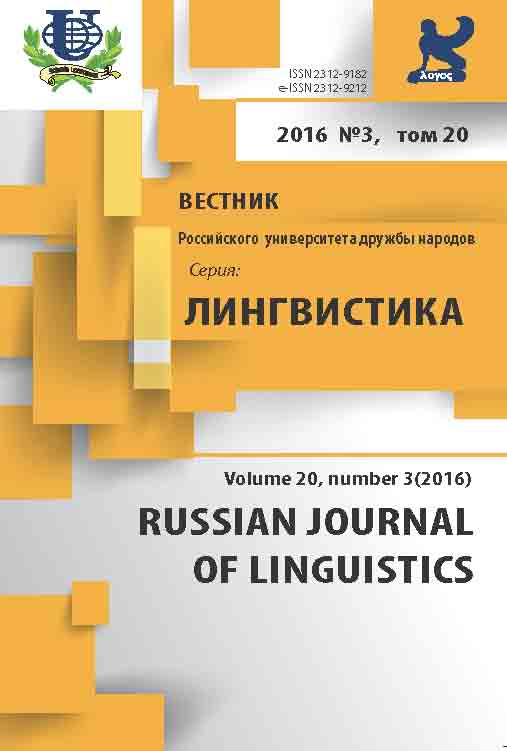From Function to System: Advances in Choosing a Matrix Structure of the Translation Process
- Authors: Remkhe I.N1, Nefedova L.A2, Gillespie D.C3
-
Affiliations:
- Magnitogorsk State Technical University named after G.I. Nosov
- Chelyabinsk State University
- University of Bath
- Issue: Vol 20, No 3 (2016)
- Pages: 230-242
- Section: Articles
- URL: https://journals.rudn.ru/linguistics/article/view/14751
Cite item
Full Text
Abstract
This article presents the authors’ view on the transition towards a new paradigm in the study of the translation process based on synergy, collaboration, networking and the cognitive structure of the translator’s mind. In the search for a hypothetical cognitive model of translation, a matrix model is represented to further enrich the interdisciplinary platform through understanding the conglomerate of the many sources involved in the act of translation and focusing on the role of the individual human being in translational cognition. The Map-Matrix Model comprises three levels of the translator’s mental space: Neurological, Representational and Conceptual. Each level corresponds to the inheritance relations between mapping patterns, clusters and frames. The model will be presented and interrogated through the results of a practical Think-aloud protocols experiment in order to give a better insight into the translation efficiency in terms of information processing and a clearer assumption of the feasibility of the concept.
Keywords
About the authors
Irina N Remkhe
Magnitogorsk State Technical University named after G.I. Nosov
Email: rilix@mail.ru
38, Lenina Prospect, 455000, Magnitogorsk, Russia
Liliya A Nefedova
Chelyabinsk State University
Email: lan2@mail.ru
129, Bratyev Kashirinykh Str., 454001, Chelyabinsk, Russia
David C Gillespie
University of Bath
Email: d.c.gillespie@bath.ac.uk
Claverton Down, Bath, North East Somerset BA2 7AY, United Kingdom
References
- Bernardini, S. (2001) Think-aloud protocols. Achievements. Limits. Future prospects, in Target 13:2, 241-263
- Berseneva T.P. (2013) Sinergiya i sinergetika: kategoriya isikhazma i sovremennaya nauka [Sinergy and Synergetics: Category of Isikhazm and Modern Science]. Vestnik Tomskogo Gosudarstvennogo Universiteta. Philosophiya. Sotsiologiya. Politologiya, no. 369, 41-47
- Buckminster, R.F. (1982) Synergetics. Explorations in the Geometry of Thinking. Macmillan Pub Co
- Byrne J. (2006) Technical Translation Usability Strategies for Translating Technical Documentation. Springer
- Chesterman, A. (1998). Communication strategies, learning strategies and translation strategies, in: Malmkjær, 135-143
- Connectionism (2015) Stanford Encyclopedia of Philosophy. Retrieved from: http://plato.stanford.edu/ entries/connectionism (accessed 10 January 2016)
- Cranmer, R. (2015). Introducing intercultural communication into the teaching of translation. Russian Journal of Linguistics. 19 (4), 155-173
- Dijk T.A. (1980). The semantics and pragmatics of functional coherence in discourse. In A. Ferrara (ed). Speech act theory: Ten years later. Milano, Italy: Versus, 49-65
- Downes, S. (2005) An Introduction to Connective Knowledge. Retrieved from: http://www.downes.ca/ post/33034 (Accessed: 09 January 2016)
- Farman, I.P. (2013). Construktivizm kak metod i sotsial’no-kul’turnaya praktika [Constructivism as method and socio-cultural practice]. In V.A. Lektorsky (ed.). Konstruktivizm v teorii poznaniya [Constructivizm in the theory of knowledge] (pp. 88-116), Rossiiskaya akademiya nauk. Institut Filosofii, Moskva: IFRAN (In Russian)
- Fauconnier, G. (1998). Mental spaces, language modalities, and conceptual integration. In M. Tomasello (ed.). The New Psychology of Language (pp. 251-279). Mahwah, NJ: Lawrence Erlbaum. Available at: http://citeseerx.ist.psu.edu/viewdoc/download?doi=10.1.1.99.9811&rep=rep1&type=pdf (accessed 21 June 2016)
- Gerloff, P. (1986). Second language learners’ reports on the interpretive process: Talk aloud protocols of translation, in: House and Blum-Kulka, 243-262
- Jääskeläinen, R. (1993). Investigating translation strategies. In S. Tirkkonen-Conditand, J. Laffling (ed.). Recent trends in empirical translation research. Joensuu: University of Joensuu Faculty of Arts, pp. 99-120
- Koskinen, K. (2015) Training translators for a superdiverse world. Translators’ intercultural competence and translation as affective work, Russian Journal of Linguistics, 19(4), 175-183
- Krings, H.P. (1986). Translation problems and translation strategies of advanced German learners of French (L2). House and Blum-Kulka, pp. 263-275
- Kushnina L.V. (2005) Vzaimodeistviye yazykov i kul’tur v perevodcheskom prostranstve: geshtal’t-sinergetichesky podkhod [Interrelation between Languages and Culture. Applying the Theory of Gestalt and Synergy] (PhD Thesis), Moskva, RGB (In Russian)
- Kushnina L.V., Geikhman L.K., Neganova A.O., (2015). Mezhyazykovaya i mezhkul’turnaya variativnost’ pri perevode tekhnicheskikh tekstov: sinergetichesky podkhod [Interlingua and Intercultural Variation in the technical Translation: Synergetic Approach]. Sovremennye problem nauki i obrazovaniya, no. 1-1. Retrieved from: http://www.science-education.ru/ru/article/view?id=19556 (accessed 10 February 2016)
- Lave, J. (1988). Cognition in Practice: Mind, mathematics, and culture in everyday life. Cambridge, UK: Cambridge University Press
- Lörscher, W. (1991). Translation performance, translation process, and translation strategies: A psycholinguistic investigation. Tübingen: Gunter Narr
- Mondahl, M, Knud A.J. (1996). Lexical search strategies in translation, Meta 41:1, 97-112
- Nefedova L.A., Remkhe I.N. (2014). Towards cognitive modelling of the technical translation process. Proceedings of the XXV Annual International Academic Conference Language and Culture, 20-22 October 2014. Procedia - Social and Behavioral Sciences, no. 154, Elsevier, 237-245
- Padilla, P., Bajo, M.T., Padilla, F. (1999) Proposal for a cognitive theory of translation and interpreting: A methodology for future empirical research, in: The Interpreters' Newsletter, no. 9 (ed. EUT), Edizioni Università di Trieste Citazione, 61-78. Retrieved from: http://hdl.handle.net/10077/2213 (accessed 25 June 2016)
- Piaget, J. (1990). The child's conception of the world. New York: Littlefield Adams
- Rosch, E. (2016, June 20). Principles of Categorization. In: Cognition and categorization (eds. E. Rosch, B. Lloyd), University of California Press, 27-48. Retrieved from: http://commonweb.unifr.ch/ artsdean/pub/gestens/f/as/files/4610/9778_083247.pdf
- Séguinot, C. (1996). Some thoughts about think-aloud protocols, in: Target 8:1, 75-95

















